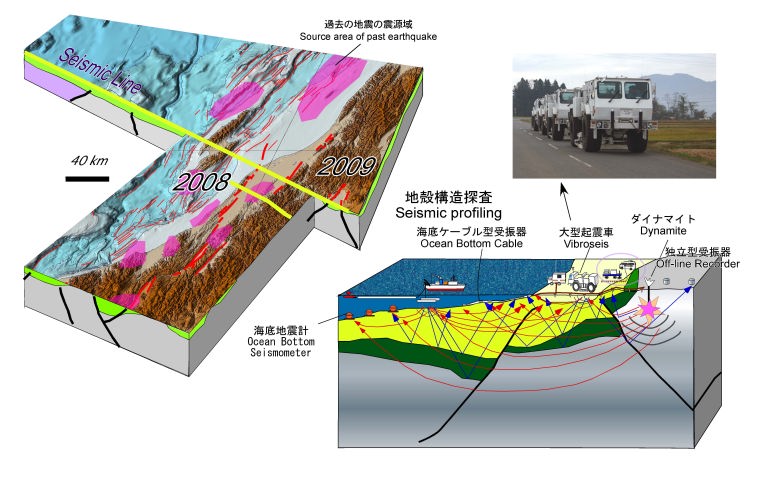ひずみ集中帯の重点的観測・研究
本州の日本海沿岸地域には褶曲-断層帯が形成され、測地学的に短縮変形が集中するひずみ集中帯を構成し、1964年新潟地震(M7.5)、2004年中越地震(M6.8)、2007年中越沖地震(M6.8)など多くの被害地震が発生している。2
008年度からこのひずみ集中帯の地殻構造や地殻の変形過程を理解するための総合的な研究が5カ年計画として開始された。地震研究所ではこのプロジェクトにおいて、海陸統合による深部地殻地震探査、海底地震計による海域の自然地震観測や陸域での電磁気構造探査、歴史地震・強震動予測についての研究を行っている。
Multidisciplinary Project on the Eastern Japan Sea Deformation Zone
A fold-and-thrust belt along the Japan Sea coast of northern Honshu is marked by a high rate of convergent strain as observed from geodetic measurement, and devastative earthquakes, such as the 1964 Niigata (M7.5), 2004 Chuetsu (M6.8) and 2007 Chuetsu-oki (M6.8) earthquakes. A multi-disciplinary research project to understand the structure and crustal deformation processes along this zone of high-strain rate began in 2008 as a five years project. This research project includes onshore-offshore deep seismic profiling, marine seismic observation using ocean bottom seismometer, electrical resistivity profiling on land, and research on historical earthquakes and strong ground motions.
図. 海陸統合地殻構造探査の概念図
2009年は海洋研究開発機構と共同で会津-佐渡西方沖の地殻構造探査を実施する。地殻構造探査では震源断層のイメージングと速度構造の解明を目的としている。
Figure. Schematic diagram showing the concept of onshore-offshore seismic profiling.
Seismic profiling aims to obtain the images of seismogenic source faults and velocity structures. In 2009 seismic profiling will be carried out along the Aizu-west Sado seismic line under collaboration with Japan Agency for Marine-Earth Science and Technology (JAMSTEC).
 |